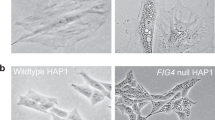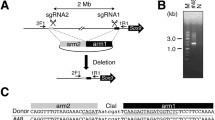Abstract
Combined lipase deficiency (cld) is a recessive, lethal mutation specific to the t w73 haplotype on mouse Chromosome 17. While the cld mutation results in lipase proteins that are inactive, aggregated, and retained in the endoplasmic reticulum (ER), it maps separately from the lipase structural genes. We have narrowed the gene critical region by about 50% using the t w18 haplotype for deletion mapping and a recombinant chromosome used originally to map cld with respect to the phenotypic marker tf. The region now extends from 22 to 25.6 Mbp on the wild-type chromosome, currently containing 149 genes and 50 expressed sequence tags (ESTs). To identify the affected gene, we have selected candidates based on their known role in associated biological processes, cellular components, and molecular functions that best fit with the predicted function of the cld gene. A secondary approach was based on differences in mRNA levels between mutant (cld/cld) and unaffected (+/cld) cells. Using both approaches, we have identified seven functional candidates with an ER localization and/or an involvement in protein maturation and folding that could explain the lipase deficiency, and six expression candidates that exhibit large differences in mRNA levels between mutant and unaffected cells. Significantly, two genes were found to be candidates with regard to both function and expression, thus emerging as the strongest candidates for cld. We discuss the implications of our mapping results and our selection of candidates with respect to other genes, deletions, and mutations occurring in the cld critical region.





Similar content being viewed by others
References
Ailhaud G (1990) Cellular and secreted lipoprotein lipase revisited. Clin Biochem 23:343–347
Appenzeller C, Andersson H, Kappeler F, Hauri HP (1999) The lectin ERGIC-53 is a cargo transport receptor for glycoproteins. Nat Cell Biol 1:330–334
Ardlie KG (1998) Putting the brake on drive: meiotic drive of t haplotypes in natural populations of mice. Trends Genet 14:189–193
Artzt K (1984) Gene mapping within the T/t complex of the mouse. III: t-Lethal genes are arranged in three clusters on chromosome 17. Cell 39:565–572
Artzt K, McCormick P, Bennett D (1982a) Gene mapping within the T/t complex of the mouse. I. t-Lethal genes are nonallelic. Cell 28:463–470
Artzt K, Shin HS, Bennett D (1982b) Gene mapping within the T/t complex of the mouse. II. Anomalous position of the H-2 complex in t haplotypes. Cell 28:471–476
Artzt K, Barlow D, Dove WF, Fischer L, Klein J, et al. (1991) Maps of mouse chromosome 17: first report. Mamm Genome 1:5–29
Babiarz B, Garrisi GJ, Bennett D (1982) Genetic analysis of the tw73 haplotype of the mouse using deletion mutations: evidence for a parasitic lethal mutation. Genet Res 39:111–120
Barclay J, King TF, Crossley PH, Barnard RC, Larin Z, et al. (1996) Physical analysis of the region deleted in the tw18 allele of the mouse tcl-4 complementation group. Genomics 36:39–46
Ben-Zeev O, Doolittle MH (2004) Maturation of hepatic lipase. Formation of functional enzyme in the endoplasmic reticulum is the rate-limiting step in its secretion. J Biol Chem 279:6171–6181
Ben-Zeev O, Mao HZ, Doolittle MH (2002) Maturation of lipoprotein lipase in the endoplasmic reticulum. Concurrent formation of functional dimers and inactive aggregates. J Biol Chem 277:10727–10738
Bennett D (1975) The T-locus of the mouse. Cell 6:441–454
Bergstrom DE, Bergstrom RA, Munroe RJ, Lee BK, Browning VL, et al. (2003) Overlapping deletions spanning the proximal two-thirds of the mouse t complex. Mamm Genome 14:817–829
Boedeker JC, Doolittle MH, White AL (2001) Differential effect of combined lipase deficiency (cld/cld) on human hepatic lipase and lipoprotein lipase secretion. J Lipid Res 42:1858–1864
Briquet-Laugier V, Ben-Zeev O, White A, Doolittle MH (1999) cld and lec23 are disparate mutations that affect maturation of lipoprotein lipase in the endoplasmic reticulum. J Lipid Res 40:2044–2058
Coleman T, Seip RL, Gimble JM, Lee D, Maeda N, et al. (1995) COOH-terminal disruption of lipoprotein lipase in mice is lethal in homozygotes, but heterozygotes have elevated triglycerides and impaired enzyme activity. J Biol Chem 270:12518–12525
Davis RC, Ben-Zeev O, Martin D, Doolittle MH (1990) Combined lipase deficiency in the mouse. Evidence of impaired lipase processing and secretion. J Biol Chem 265:17960–17966
Dietrich WF, Miller JC, Steen RG, Merchant M, Damron D, et al. (1994) A genetic map of the mouse with 4,006 simple sequence length polymorphisms. Nat Genet 7:220–245
Ebersole T, Lai F, Artzt K (1992) New molecular markers for the distal end of the t-complex and their relationships to mutations affecting mouse development. Genetics 131:175–182
Fox HS, Silver LM, Martin GR (1984) An alpha globin pseudogene is located within the mouse t complex. Immunogenetics 19:125–130
Ha H, Howard CA, Yeom YI, Abe K, Uehara H, et al. (1991) Several testis-expressed genes in the mouse t-complex have expression differences between wild-type and t-mutant mice. Dev Genet 12:318–332
Hammer MF, Schimenti J, Silver LM (1989) Evolution of mouse chromosome 17 and the origin of inversions associated with t haplotypes. Proc Natl Acad Sci USA 86:3261–3265
Hauri HP, Kappeler F, Andersson H, Appenzeller C (2000) ERGIC-53 and traffic in the secretory pathway. J Cell Sci 113(Pt 4):587–596
Helenius A, Aebi M (2004) Roles of N-linked glycans in the endoplasmic reticulum. Annu Rev Biochem 73:1019–1049
Herrmann BG, Koschorz B, Wertz K, McLaughlin KJ, Kispert A (1999) A protein kinase encoded by the t complex responder gene causes non-mendelian inheritance. Nature 402:141–146
Himmelbauer H, Pohlschmidt M, Snarey A, Germino GG, Weinstat-Saslow D, et al. (1992) Human-mouse homologies in the region of the polycystic kidney disease gene (PKD1). Genomics 13:35–38
Himmelbauer H, Harvey RP, Copeland NG, Jenkins NA, Silver LM (1994) High-resolution genetic analysis of a deletion on mouse chromosome 17 extending over the fused, tufted, and homeobox Nkx2-5 loci. Mamm Genome 5:814–816
Homanics GE, de Silva HV, Osada J, Zhang SH, Wong H, et al. (1995) Mild dyslipidemia in mice following targeted inactivation of the hepatic lipase gene. J Biol Chem 270:2974–2980
Howell GR, Bergstrom RA, Munroe RJ, Masse J, Schimenti JC (2004) Identification of a cryptic lethal mutation in the mouse t(w73) haplotype. Genet Res 84:153–159
Kim PS, Arvan P (1998) Endocrinopathies in the family of endoplasmic reticulum (ER) storage diseases: disorders of protein trafficking and the role of ER molecular chaperones. Endocr Rev 19:173–202
Klein J, Sipos P, Figueroa F (1984) Polymorphism of t-complex genes in European wild mice. Genet Res Camb 44, 39–46
Lowe ME (2002) The triglyceride lipases of the pancreas. J Lipid Res 43:2007–2016
Martin GR, Silver LM, Fox HS, Joyner AL (1987) Establishment of embryonic stem cell lines from preimplantation mouse embryos homozygous for lethal mutations in the t-complex. Dev Biol 121:20–28
Mead JR, Irvine SA, Ramji DP (2002) Lipoprotein lipase: structure, function, regulation, and role in disease. J Mol Med 80:753–769
Morita T, Kubota H, Murata K, Nozaki M, Delarbre C, et al. (1992) Evolution of the mouse t haplotype: recent and worldwide introgression to Mus musculus. Proc Natl Acad Sci USA 89:6851–6855
Nagata K (1998) Expression and function of heat shock protein 47: a collagen-specific molecular chaperone in the endoplasmic reticulum. Matrix Biol 16:379–386
Nichols WC, Seligsohn U, Zivelin A, Terry VH, Hertel CE, et al. (1998) Mutations in the ER-Golgi intermediate compartment protein ERGIC-53 cause combined deficiency of coagulation factors V and VIII. Cell 93:61–70
Olivecrona T, Chernick SS, Bengtsson-Olivecrona G, Paterniti JR Jr, Brown WV, et al. (1985) Combined lipase deficiency (cld/cld) in mice. Demonstration that an inactive form of lipoprotein lipase is synthesized. J Biol Chem 260:2552–2557
Paterniti JR Jr, Brown WV, Ginsberg HN, Artzt K (1983) Combined lipase deficiency (cld): a lethal mutation on chromosome 17 of the mouse. Science 221:167–169
Perret B, Mabile L, Martinez L, Terce F, Barbaras R, et al. (2002) Hepatic lipase: structure/function relationship, synthesis, and regulation. J Lipid Res 43:1163–1169
Peterfy M, Phan J, Reue K (2005) Alternatively spliced lipin isoforms exhibit distinct expression pattern, subcellular localization, and role in adipogenesis. J Biol Chem 280:32883–32889
Reue K, Doolittle MH (1996) Naturally occurring mutations in mice affecting lipid transport and metabolism. J Lipid Res 37:1387–1405
Sano Y, Shimada T, Nakashima H, Nicholson RH, Eliason JF, et al. (2001) Random monoallelic expression of three genes clustered within 60 kb of mouse t complex genomic DNA. Genome Res 11:1833–1841
Schimenti J (2000) Segregation distortion of mouse t haplotypes the molecular basis emerges. Trends Genet 16:240–243
Schroder M, Kaufman RJ (2005) ER stress and the unfolded protein response. Mutat Res 569:29–63
Scow RO, Schultz CJ, Park JW, Blanchette-Mackie EJ (1998) Combined lipase deficiency (cld/cld) in mice affects differently post-translational processing of lipoprotein lipase, hepatic lipase and pancreatic lipase. Chem Phys Lipids 93:149–155
Silver LM (1990) At the crossroads of developmental genetics: the cloning of the classical mouse T locus. Bioessays 12:377–380
Silver LM, Artzt K (1981) Recombination suppression of mouse t-haplotypes due to chromatin mismatching. Nature 290:68–70
Sutherland HF, Pick E, Francis F, Lehrach H, Frischauf AM (1995) Mapping around the Fused locus on mouse chromosome 17. Mamm Genome 6:449–453
Vernet C, Artzt K (1995) Mapping of 12 markers in the proximal region of mouse chromosome 17 using recombinant t haplotypes. Mamm Genome 6:219–221
Vernet C, Abe K, Artzt K (1998) Genetic mapping of 10 microsatellites in the t complex region of mouse chromosome 17. Mamm Genome 9:472
Walmsley AR, Batten MR, Lad U, Bulleid NJ (1999) Intracellular retention of procollagen within the endoplasmic reticulum is mediated by prolyl 4-hydroxylase. J Biol Chem 274:14884–14892
Wong H, Schotz MC (2002) The lipase gene family. J Lipid Res 43:993–999
Yeom YI, Abe K, Artzt K (1992) Evolution of the mouse H-2K region: a hot spot of mutation associated with genes transcribed in embryos and/or germ cells. Genetics 130:629–638
Acknowledgments
The authors thank Gail Martin for the kind gift of ES cells carrying the t w18 deletion, and Karen Artzt for sharing DNA from t-haplotype-specific mice. In particular, we are indebted to Karen Artzt for supplying DNA from a recombinant mouse derived from her original elegant studies that first identified the cld mutation, and her many helpful discussions and encouragement over the years. This work was funded by National Institutes of Health grant HL28481 and the Veterans Administration.
Author information
Authors and Affiliations
Corresponding author
Rights and permissions
About this article
Cite this article
Péterfy, M., Mao, H.Z. & Doolittle, M.H. The cld mutation: narrowing the critical chromosomal region and selecting candidate genes. Mamm Genome 17, 1013–1024 (2006). https://doi.org/10.1007/s00335-006-0045-3
Received:
Accepted:
Published:
Issue Date:
DOI: https://doi.org/10.1007/s00335-006-0045-3




